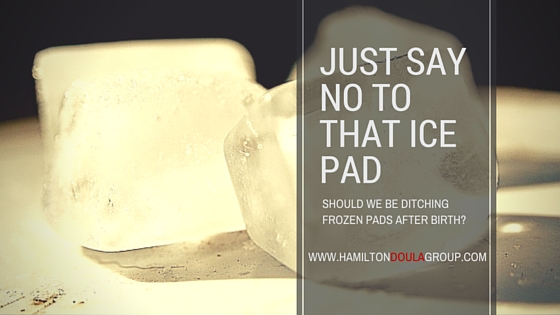Ice is often recommended at two key points in birth and the postpartum period: to dull back pain during labour and to help heal women’s sore bottoms after birth. In fact, it’s protocol after birth for women in hospital to strap on a giant frozen pad before moving from Labour & Delivery to the Postpartum unit.
It’s such a common practice that there are dozens of articles and recipes for DIY frozen healing pads on Pinterest. I looked at Hamilton Doula Group’s Pinterest boards and even we have a recipe in our many curated links.
Research is showing that ice is NOT good for healing.
The creator of the RICE Protocol – Rest Ice Compression Elevation – has reviewed the latest research and is now recommending abandoning ice. While ice can reduce pain locally, it slows healing, increases stiffness in the muscles, reduces mobility of the muscles and makes the muscles weaker. None of these things are good for a mother with a swollen perineum.
The new recommendation is to BE CALM which stands for Breathe Evaluate Compression Able Actions ELevation and Minimal Ice.
What does that mean for postpartum healing?
First it means we should stop putting ice pads and packs on women’s bottoms after birth. The ice slows down the circulation to the area it’s applied to which runs counter to helping the healing process. And heat increases the circulation too much so that’s not the right solution, either. According to the BE CALM Protocol we should allow “the inflammatory process to proceed at the rate appropriate to the level of injury.”
Most doctors, nurses and midwives prescribe and administer either or both Acetaminophen and Ibuprofen for managing pain and excessive swelling. This, accompanied by rest, is likely all women need for normal postpartum healing.
Did you make or wear frozen pads and packs after birth?

